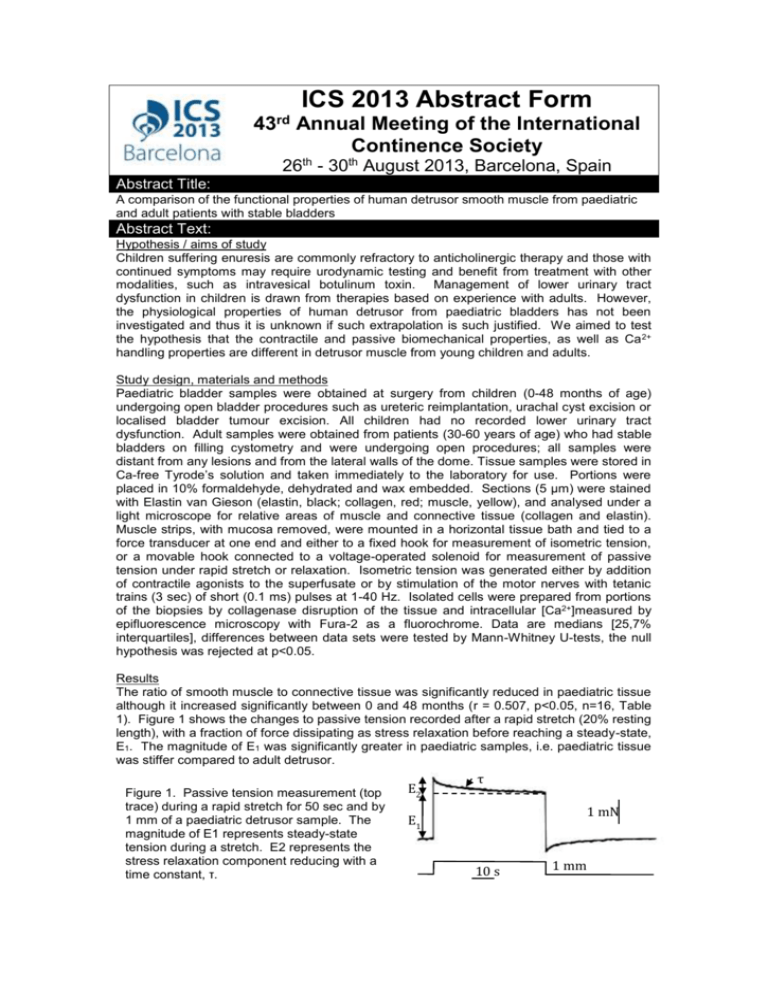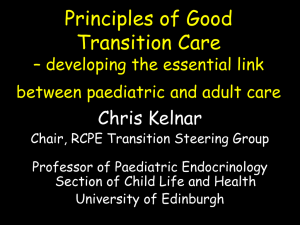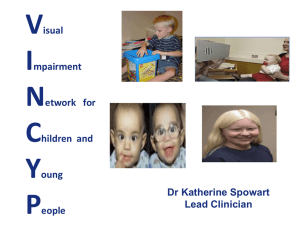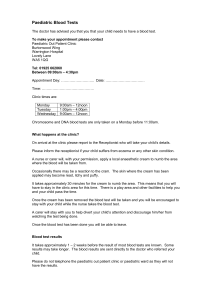undergoing excision
advertisement

ICS 2013 Abstract Form 43rd Annual Meeting of the International Continence Society 26th - 30th August 2013, Barcelona, Spain Abstract Title: A comparison of the functional properties of human detrusor smooth muscle from paediatric and adult patients with stable bladders Abstract Text: Hypothesis / aims of study Children suffering enuresis are commonly refractory to anticholinergic therapy and those with continued symptoms may require urodynamic testing and benefit from treatment with other modalities, such as intravesical botulinum toxin. Management of lower urinary tract dysfunction in children is drawn from therapies based on experience with adults. However, the physiological properties of human detrusor from paediatric bladders has not been investigated and thus it is unknown if such extrapolation is such justified. We aimed to test the hypothesis that the contractile and passive biomechanical properties, as well as Ca 2+ handling properties are different in detrusor muscle from young children and adults. Study design, materials and methods Paediatric bladder samples were obtained at surgery from children (0-48 months of age) undergoing open bladder procedures such as ureteric reimplantation, urachal cyst excision or localised bladder tumour excision. All children had no recorded lower urinary tract dysfunction. Adult samples were obtained from patients (30-60 years of age) who had stable bladders on filling cystometry and were undergoing open procedures; all samples were distant from any lesions and from the lateral walls of the dome. Tissue samples were stored in Ca-free Tyrode’s solution and taken immediately to the laboratory for use. Portions were placed in 10% formaldehyde, dehydrated and wax embedded. Sections (5 µm) were stained with Elastin van Gieson (elastin, black; collagen, red; muscle, yellow), and analysed under a light microscope for relative areas of muscle and connective tissue (collagen and elastin). Muscle strips, with mucosa removed, were mounted in a horizontal tissue bath and tied to a force transducer at one end and either to a fixed hook for measurement of isometric tension, or a movable hook connected to a voltage-operated solenoid for measurement of passive tension under rapid stretch or relaxation. Isometric tension was generated either by addition of contractile agonists to the superfusate or by stimulation of the motor nerves with tetanic trains (3 sec) of short (0.1 ms) pulses at 1-40 Hz. Isolated cells were prepared from portions of the biopsies by collagenase disruption of the tissue and intracellular [Ca2+]measured by epifluorescence microscopy with Fura-2 as a fluorochrome. Data are medians [25,7% interquartiles], differences between data sets were tested by Mann-Whitney U-tests, the null hypothesis was rejected at p<0.05. Results The ratio of smooth muscle to connective tissue was significantly reduced in paediatric tissue although it increased significantly between 0 and 48 months (r = 0.507, p<0.05, n=16, Table 1). Figure 1 shows the changes to passive tension recorded after a rapid stretch (20% resting length), with a fraction of force dissipating as stress relaxation before reaching a steady-state, E1. The magnitude of E1 was significantly greater in paediatric samples, i.e. paediatric tissue was stiffer compared to adult detrusor. Figure 1. Passive tension measurement (top trace) during a rapid stretch for 50 sec and by 1 mm of a paediatric detrusor sample. The magnitude of E1 represents steady-state tension during a stretch. E2 represents the stress relaxation component reducing with a time constant, τ. E2 τ 1 mN E1 10 s 1 mm Carbachol (0.1-10 µM, carb) and α,β–methylene ATP (10 µM, ABMA) generated contracures in adult and paediatric samples but the magnitudes were less in paediatric samples. However, when normalised to the amount of smooth muscle in the preparation, contractures were of similar magnitudes in the two groups (Table 1). However, the potency to carbachol (pEC50) was reduced in paediatric samples (Table 1). Nerve-mediated contractions measured at 40 Hz were significantly less in paediatric samples, and remained so when normalised for muscle content. Atropine-resistance to nerve-mediated contractions contributed about 50% of the total contraction in paediatric samples but was almost absent in adult samples (Table 1). The percentage of atropine-resistant contraction was independent of age between 0 and 48 months. Resting intracellular [Ca2+] was similar in cells from paediatric and adults bladders (Table 2). Moreover the magnitude of Ca2+ transients to carbachol (10 µM), ABMA (10 µM), caffeine (10 mM, to release Ca2+ from intracellular stores) and high-K solution (80 mM, to depolarise detrusor myocytes) was similar in myocytes from paediatric and adult bladders. Table 1. Detrusor from paediatric and adult human bladders – histology and tension values. SM/CT E1, Carb, Carb, ABMA, T40, Atr resist ratio mN/mm2 mN/mm2 pEC50 mN/mm2 mN/mm2 % Paediatric 2.16 * 2.39 * 48.2 5.52 * [1.67,3.05] [1.11,4.05] [18.3,69.0] [5.67,5.37] 12.2 9.18 * 58.3 * [6.20,18.9] [4.09,13.5] [35.6,74.7] Adult 6.63 0.62 64.8 6.59 [5.93,7.51] [0.36,0.99] [46.1,91.7] [6.96,6,29] 20.4 59.6 0.4 [16.5,32.8] [29.8,80.0] [0.0, 8.3] Table 2. Detrusor from paediatric and adult human bladders – intracellular [Ca2+], [Ca2+]i, values. Resting ∆[Ca2+]i, ∆[Ca2+]i, ∆[Ca2+]i, ∆[Ca2+]i, 2+ [Ca ]i, nM carb, nM ABMA, nM caff, nM KCl, nM Paediatric Adult 67 [38,111] 326 [117,594] 313 [145,652] 340 [207,554] 272 [159,397] 67 [86,63] 386 [325,469] 347 [324,371] 432 [252, 590] 305 [290,430] Interpretation of results Human detrusor muscle from paediatric patients between 0 and 48 months showed several structural and functional differences from adult tissue. Paediatric tissue had a greater proportion of connective tissue, that increased during 48 months but did not reach the adult value at this time. We interpret the greater amont of connective tissue as contributing to the increased passive stiffness of the tissue – a property that would tend to decrease bladder compliance in vivo. Paediatric tissue developed smaller contractions to contractile agonists (carbachol, ABMA) and nerve-mediated stimulation. For contractile agonists the difference disappeared when the relative amounts of smooth muscle were accounted for. The similarity of agonist contractions in the two groups was mirrored in the similarity of intracellular [Ca 2+] transients to contractile agonists. However, nerve-mediated contractions remained substantially smaller and we interpret this as a relative functional denervation in paediatric tissue. Purinergic-dependent atropine resistance accounted for about 50% of the nervemediated contraction in paediatric tissue but was absent in adult tissue. Concluding message Paediatric human detrusor muscle is less contractile than adult tissue when both are collected from stable bladders. The smaller contractions are not due to differences in smooth muscle function per se but are due to a smaller proportion of smooth muscle and a functional denervation. Acetylcholine and ATP exert equivalent effects as neurotransmitters to generate muscle contraction in paediatric bladder and phenomenon lost in adult tissue that used solely acetylcholine and may contribute to refractoriness to antimuscarinic agents in children with lower urinary tract disorders.




